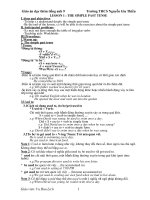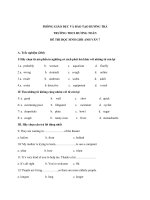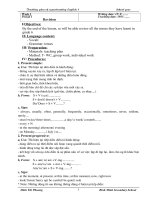Giáo án tiếng anh lớp 7 soạn theo chương trình VNEN mới tham khảo (4)
Bạn đang xem bản rút gọn của tài liệu. Xem và tải ngay bản đầy đủ của tài liệu tại đây (138.79 KB, 10 trang )
Date of writing: 9/9/2014 English 7
Date of teaching__/___2014
Week 4
Period 10
Unit 2: HEALTH
Lesson 2: A CLOSSER LOOK 1
I. Aims and objectives:
- By the end of the lesson, students will be able to:
+Practice vocabulary related to health issues
+ Know how to pronounce the sounds /f/ and /v/
+Find out the words with the sounds /f/ and /v/
II. Language content:
* Grammar: have a/an + N, have + N, feel + adj to talk about health problems
-Sounds /f/, /v/
*Vocabulary: about health problems
III. Teaching aids:
- Textbooks, teaching plan, extra board, radio
IV. Procedure:
Tim
e
Teacher’s activities Students’ activities
4' I. Warm up Giving advice
- T calls on one student to the board.
He/she uses gesture to express the
health problem.
- Other ss ask him/her : Do you have
(a/an) ? Do you feel ?
-Introduce the new lesson
- Take part in the game
6'
II. The new lesson
A. Vocabulary
-Teacher uses different
techniques to teach
vocabulary (situation,
realia, examples)
- Follow the seven steps of
teaching vocab.
* Checking vocab: What
and where
- T writes have a/an, have,
feel on the board then asks
ss to read the words from
the first column. T write the
words in a word web
-cough (n/v): ho
- headache (n) cơn đau đầu
-temperature (n): nhiệt độ
-earache (n): cơn đau tai
- sore throat (n): cơn đau họng
-weak (adj): yếu
-patient (n): bệnh nhân
-problem (n): vấn đề
Date of writing: 9/9/2014 English 7
around have a/an . T
repeats for the next two
columns.
have a/an have
cough flu sick
headache stomachache tired
sore throat toothache weak
temperatur
e
earache
3'
5'
7'
10'
1. Look at the pictures. Write the
problem below the picture of each
patient
- T asks ss to do the exercise
individually
- T corrects the exercise as a class
2. Now, read the doctor's note about
his patient and fill in the missing
words
- T asks ss to do the exercise
individually
- T corrects the exercise as a class
3. Role- play the meeting with the
doctor
-T explains how to do this activity
then asks one student to come to the
front of the class and models with
him/her
- Ask ss to work in pairs
- Call on some pairs to practise in front
of the class then ask : What was Mia's
problem? What advice did Dr Thao
have?
4. Choose a health problem. Work in
groups. Tell your group about the last
time you had that problem ( 7')
- T asks 4 ss to model the example
conversation then T divides the class
into groups of 4 ss and asks ss to talk
about a health problem
- T may ask ss to extend the
conversation by trying to figure out
what the most common health problem
in the group and then report back to the
class
- Do the exercise individually
Key:
1. flu 2. sunburn 3. allergy
4. tired/weak
Key:
1. (a) sunburn 2. the flu 3.
tired, temperature 4. sick,
stomachache 5. sore throat
- Work in pairs to role-play
- Work in groups of 4 ss to practice
Eg :
A: I had flu two weeks ago
B: Me too! I felt so weak
C: Oh, I had a sore throat yesterday
D: I had toothache. I think I ate too
many sweets
Date of writing: 9/9/2014 English 7
B. Pronunciation
- Teacher explains how to to pronounce
the sounds /f/ and /v/ and models
Đặc tính của âm /f/ là phụ âm vô thanh
(voiceless consonant) âm môi răng, kết
hợp răng hàm trên và môi dưới để phát
âm (labio-dental). Đây là phụ âm xát
(fricative). Cách phát âm: đặt sát răng
hàm trên trên môi dưới, thổi luồng hơi đi
ra qua môi, miệng hơi mở một chút.
Trong khi đó âm /v/ vốn là phụ âm hữu
thanh (voiced consonant) âm môi răng,
kết hợp răng hàm trên và môi dưới để
phát âm (labio-dental). /v/ là phụ âm xát
(fricative). Nó được phát âm như sau: vị
trí và cách phát âm tương tự như khi phát
âm /f/, đặt hàm trên lên trên môi dưới, để
luồng hơi đi ra qua môi và răng, miệng
hơi mở một chút. Dùng giọng tạo ra phụ
âm kêu.
5. Lissten and circle the words you
hear
- Go through the words in the table
- Play the recording and have circle the
words they hear
6. Listen and circle the words the /f/
or /v/ sounds. They say the sentences
- T asks ss to listen to the sentences once
and repeat then asks ss to circle the
words with /f/ or/v/ sounds
- T has ss listen to the recording again and
gives the correct answers to the entire
class
- Listen to the teacher and look at the
model
- Listen and circle
Key:
1. fat 2. ferry 3. vast 4.
vault
5. save 6. leave
- Listen , circle the words and say the
sentences
Key :
1. fast, food 2. have, felt 3. father
4. having, lifestyle 5. give
2'
2'
III. Consolidation
-Have a/an + N, have + N, feel + adj
to talk about health problems
- How to pronounce the sounds /f/
and /v/
? Recall some phrases which has the
two sounds.
- Recall the lesson
Date of writing: 9/9/2014 English 7
IV. Homework
Learn by heart all the new words and
structures.
-Guide ss how to do A1,2 P10
- Prepare: A closer look 2
-Listen to the teacher
Date of teaching__/___2014
Week 4
Period 11
Unit 2: HEALTH
Lesson 3: A CLOSSER LOOK 2
I. Aims and objectives:
- By the end of the lesson, the students will be able to understand about imperative with
more and less
II. Language content:
* Grammar: Imperatives with more and less
*Vocabulary: health tips
III. Teaching aids:
- Textbooks, teaching plan, extra board, radio
IV. Procedure:
Time Teacher’s activities Students’ activities
4' I. Warm up
- Play the game: Simon says
- Introduce the new lesson
- Take part in the game
10'
II.The new lesson
A. Presentation
1. Vocabulary
-Teacher uses different
techniques to teach
vocabulary (situation, realia,
examples)
- Follow the seven steps of
teaching vocab.
* Checking vocab: Slap the
board.
* Imperatives
- Ask ss to recall about the
game Simon says to elicit
the imperative
2. Imperatives with more
and less
-imperative (n): mệnh lệnh
- tip (n) lời khuyên
-expert (n): chuyên gia
-stay in shape (v): giữ dáng /
giữ cơ thể khoẻ
- obesity (adj): béo phì
-depression (n): sự chán nản
concentrate (v): tập trung
-limit (v): hạn chế
Date of writing: 9/9/2014 English 7
20
Model sentence: Do more
exercise
Watch less
TV
- T explains that the
imperative can be use for
direct command, orders or
suggestions
- T asks ss to read through
the yellow box
B. Practice
1. Look at the pictures.
Which advice would you
give to each of these
people? Use the
imperatives with more
and less above
- T asks ss to look at the
pictures and calls on ss to
tell the class what they see.
- T asks ss to work in pairs
to practice and they can
give the reasons for the
advice
- Call on some pairs to
practice
* Imperatives with more
and less
Model sentences: Do more
exercise
Watch less
TV
Don't play
more games
Usage: the imperative can
be use for direct command,
orders or suggestions
Possible answers:
a. Drink more water/ sleep
more
b. Spend less time playing
computer games
c. Do more excise
d. Sunbathe less
2. Top Health Tip for teen
- Ask ss to look at the yellow
Grammar box again then work in
groups of 4 ss to choose 6 pieces of
advice are most important for teen .
- T let ss discuss their idea in their
groups
- Ask some groups represent their ideas
3. Look at the articles on the Teen
Health website. Fill in the blanks to
complete their top six health tips
- T ask ss to read through the Teen
Health website individually and
complete the heading
-T may encourage class discussion
-Look at the yellow Grammar box
again then work in groups of 4 ss to
choose 6 pieces of advice are most
important for teen then discuss
-Read through the Teen Health website
individually and complete the heading
- Discuss
Key:
1. Do more exercise
2. Sleep more
Date of writing: 9/9/2014 English 7
about why some pieces of advice are
more important than others
Grammar:
1. Compound sentences
- T write the word : CONJUNTION on
a big piece of paper
- T writes: AND, BUT, OR ,SO on the
board then ask ss : What these words
are called.
- T ask 2 ss to come and stand in front
of the class. T brings out the paper with
CONJUNCTION written on it and
asks 2 ss each hold the paper with one
hand
- T asks what a conjunction does and
ss can answer.
- T lets ss read the first paragraph of
the Yellow Box and asks :
What do we call a sentence made by
linking two simple sentences ?
- T divides the class into 3 groups. The
first group is Independent Clause 1.
The second group is conjunction and
the third group is conjunction 2.
The whole class reads the table aloud
- T asks ss to read through the yellow
box
2. Make compound sentences by
joining the two simple sentences.
Using the conjunction give
- T asks ss to complete the exercise
individually
- T corrects the exercise with the class
3. Match the beginning of the
sentences with the picture that
completes them
- T has ss look at the pictures and go
through the beginning of the sentences
and work individually
4. Now complete the second part of
the compound sentences
- Ask ss to go through the first
3. Eat less junk food
4. Wash your hand more
5 Watch less TV
6. Spend less time playing computer
games
- It joins two simple sentences
Eg: T : Independent 1
G1: The Japanese eat a lot of rice
Compound sentences
Compound sentences: When we want
to join two ideas, we can link two
simple sentences to form a compound
sentences , we can use and (for
addition), or (for choice), but(for a
contrast), so ( for a result)
There is usually is comma(,) after the
first independent clause
Key
1. I want to eat some food, but I have
a sore throat
2. The Japanese eat healthier , so they
live for a long time
3. I feel tired and I feel weak
4. You can go and see the doctor, or
you can go to bed now and rest
compound(n):ghép
-independent (adj): độc lập
-coordinate(v): kết hợp
-conjunction(n): liên từ
-clause(n): mệnh đề
Date of writing: 9/9/2014 English 7
6'
3'
2'
sentences and work individually to
complete the sentences
5. Read the quote about health
below, Explain each quote to your
partner, Discuss the similarities and
differences
- T asks ss to read the quote aloud
-T asks comprehension questions :
- Tasks ss to discuss the similarities
and the differences
C . Production
- Ask ss to work in groups of 4 ss to
give the situation and give the
imperative with less and more
III. Consolidation
- T lets ss recall about the imperatives
with less and more
IV. Home work
-Learn by heart all the new words and
structures.
-Guide ss how to do E 6,7 P12/13
- Prepare: Communication
-or( conj): hoặc là
-so(conj):vì vậy
-join(v): nối
- quote(n): trích dẫn
Where does someone ride when she
rides on horseback?
What does it mean to go some where
on foot?
When you value something do you
think it's important or not?
_____________________________________
Date of teaching__/___2014
Week 4
Period 12
Unit 2: HEALTH
Lesson 4: Communication
I. Objective .
By the end of the lesson, Ss will be able to:
- Practice talking about some opinions are true and some are false about health
II. Language content .
- Vocabulary: Extra vocabulary about health
- Grammar: compound sentences
III. Preparation
- Teaching aids: Textbook, posters, picture
- Work arrangement: T-WC, group work, pair work
Date of writing: 9/9/2014 English 7
- Anticipated problems: - The lesson is long, there may be not enough time for the
Project
IV. Procedure
Tim
e
Teacher's activities Students' activities
5' I.Warm up Noughts and
crosses
- T divides the class into 2
teams and asks ss to make
sentences from the word(s)
given in the table.
so watch/less and
do/more but eat/more
spend/
less
eat/ less or
- Take part in the game
13'
19'
II. The new lesson
A. Presentation
* Vocabulary
- Teacher follows the seven
steps of teaching vocab
- Use different techniques to
teach
-Check vocabulary : Slap
the board
1. Discuss the sentences to
choose true or false
sentences
- Go through the sentences
- Ask ss to work in pairs to
decide which sentences are
true or false
- T collects ss' ideas
B. Practice
1. Listen to the radio show
about health fact or myths
and check your answers in
-myth (n): điều
hoang
đường
-
vegetarian
(n): người ăn
chay
-fact ( n) : sự thật
-recover (v): hồi phục
-
surprising
(adj) ngạc nhiên
- drop (v) làm rơi
-pick up st (v) nhặt cái gì
1. Discuss the sentences to
choose true or false
sentences
- Work in pairs to decide
which sentences are true or
false
2. Listen to the radio show
Date of writing: 9/9/2014 English 7
1
- T asks ss to listen to the
recording to check their
answer
- Give feedback
- T confirms the correct
answers
about health fact or myths
and check your answers in
1
- Listen to the recording to
check the answer
Key:
1- T, 2-F, 3-F, 4-F, 5-F, 6-F
2.Discuss the following in groups
- T has ss work in groups to do this
activity
- T calls on some groups to represent
their ideas
3.Discuss the following in groups
-Work in groups to do this activity
Possible answer
1. Number 3 makes me surprising
most because I always think that
fish , rice and vegetables are good
for our health and now I know the
amount is very important
2. I know that when we have sore
eyes we shouldn't eat sticky rice,
egg. I heard this from my mother
9'
2'
2'
C. Production
1. Think of some sentences about
health that are true and some are
false
- T sets the time about 6 minutes for ss
to work in groups of 4 ss to find out
2. Test another group to see how
many of your health myths they can
spot
- T asks ss to choose one spokesperson
in each group to consult other group
III. Consolidation
- T reminds ss some sentences about
health are true which ss should follow
and some sentences are not true and ss
should avoid
IV. Home work
-Ask ss to learn by heart vocabulary and
structures.
- - Guide ss how to do Ex A2,23 P 11
(Workbook)
- Prepare next lesson. Unit 2. Lesson 5
Skills 1
4. Think of some sentences
about health that are true and
some are false
- Work in groups
Possible answer :
True : - We shouldn't quit our break
fast because it is very important
False : Women after bearing don't
take a bath for along time
E.g:1. I find making pottery boring
because we have to sit still and make
things by hands.
2. I think dancing is ineresting
because you can enjoy lovely
melody of the music you like while
you are dancing.
Date of writing: 9/9/2014 English 7
Ngày____tháng____năm 2014
BGH duyệt Tổ chuyên môn duyệt









